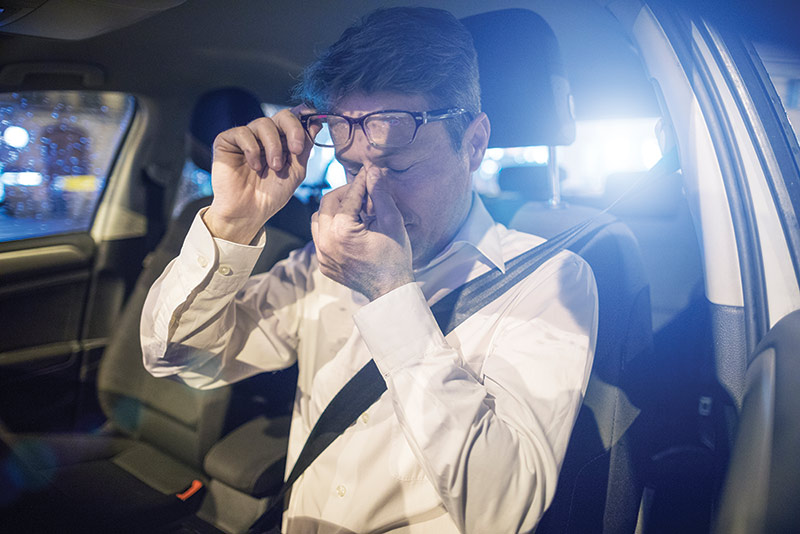Sponsored by IOT
By Deborah Kotob, ABOM

Driving day and night is a visually complex task requiring optimal vision in all light conditions to quickly react, spot and respond to traffic signals, pedestrians, other cars or road hazards. Eyeglass lenses can add to the visual challenge for drivers, especially at night. Fortunately, lenses like the IOT Endless Drive are designed to improve the wearer’s visual acuity for a more comfortable driving experience.
Our vision requirements change according to illumination. Driving in low illuminance mesopic (twilight) or scotopic (dark) conditions is especially challenging due to the poor vision experienced in low light conditions and due to poor glare recovery from oncoming headlights, as well as the need to visually adapt across a range of rapidly changing light levels and focal distances. All these induce changes in visual perception, including loss of visual acuity, increased glare and night myopia. Night driving occurs primarily in mesopic low light conditions, where we use a combination of cone and rod photoreceptor responses to see. Our central fovea, which is responsible for sharp central vision, lacks rod photoreceptors, creating a blind spot in our central vision in scotopic dark conditions. Our centrally focused distance vision is poor at these light levels. Furthermore, in low illumination, the pupil size increases, letting in more stray light, making the defocus more noticeable.
Considering that fatal crashes at night occur two to four times more than in the daytime, it is not surprising many of us opt out of night driving. Crash database analysis have demonstrated that poor visibility at night, rather than increased fatigue and alcohol, is the main reason for the elevated pedestrian fatality rate at night, which is seven times that in the daytime.
When designing the IOT Endless Drive (SV and PAL), the lenses had to address fixation changes during daylight illuminance versus night driving conditions. At nighttime, our fixation area is smaller than the fixation area for daytime driving, and the eye tends to fixate lower. Driving lenses must also address nocturnal or night myopia. Studies show that drivers affected by night myopia are around three times more likely to be involved in nighttime accidents—night myopia results in blurred distance vision under dim illumination levels. Our visual systems’ accommodative response differs depending on light conditions.
Thomas Young was the first to observe that spherical aberration (SA) of the eye changed its sign with accommodation. In the research paper, “Night Myopia Studied with Adaptive Optics Visual Analyzer,” Pablo et al., state: “…the experiment showed the average relative defocus at low luminance conditions was completely accounted for by the errors in accommodation.” In “Shedding Light on Night Myopia,” the researchers state: “…under photopic conditions, the optimum refractive state of the accommodating eye is significantly more myopic when maximizing perceived quality of a point source on a dark background compared to a conventional letter chart with black letters on a white background. Optical modeling suggested this difference in refractive state is due to spherical aberration. Since isolated point sources are more likely encountered at night, whereas extended objects are more likely encountered in the daytime, our results suggest that a significant part of the night myopia phenomenon is determined by the nature of the visual stimulus and the visual task used to assess ocular refractive state. When spherical aberration is positive, the underpowered eye is plagued by spatial phase shifts, whereas the overpowered eye avoids these phase shifts. Thus, an optimum spectacle correction prescribed for daytime viewing of high-contrast letters leaves the eye slightly overpowered (i.e., under-corrected myopia) when the same correction is used at night to view bright sources on a dark background. This under correction leads to starburst patterns that demand more negative power in the correcting lenses and thus a tendency for “night myopia.”(jov.arvojournals.org/article.aspx?articleid=2191990)
IOT Endless Drive single vision and PAL designs improve day and night driving by utilizing Digital Ray-Path 2 in the lens optimization process, incorporating the intelligent use of the wearer’s accommodation into the traditional calculations for reducing oblique aberrations, resulting in a superior personalized lens. The power distribution of the Endless Drive lens is optimized for distance vision. It incorporates up to -0.25 D of minus power in the night vision zone located above the main direction of gaze, compensating for the difference in refractive error that occurs between day and night, and providing greater visual acuity and reduced eyestrain. Endless Drive Progressive lenses are uniquely configured, producing 70 percent wider distance and 45 percent wider upper-intermediate compared to premium general-use PAL lenses. Wearers will enjoy expanded views of the road, dashboard and mirrors. IOT Endless Drive is best when combined with a blue filter coating to focus distant objects better and reduce visual fatigue while driving at night. AR coatings attenuate internal lens reflections that cause ghosting and halos at night for eyeglass wearers. Help your patients improve night driving comfort with Endless Drive lenses, and don’t forget to include a blue filter AR.













